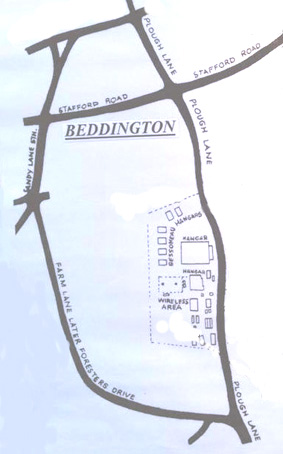|
In 1916 a wooden Air Traffic
Control and Customs building was erected at Beddington. More
aircraft were stationed there as the war progressed, and 1916
and 1917 saw Sopwith Camel's and Sopwith Pup's as well as Avro
504's take up the challenge against marauding Zepplins and Gotha
bombers. |
 |
|
The map
above shows Beddington airfield set between Stafford Rd, Farm
Lane, and Plough Lane where it had it's ground traffic entrance. |
|
|
(below) Ground crew 1918. |
 |
|
 |
|
(above) a group photograph of RFC members
at Beddington |
|
|
(below) an R.E.8. of the RFC at Beddington |
 |
|
 |
|
(above) 'SE5's at Beddington |
|
|
|
|
(below) RFC at Beddington with a motorbike |
 |
|
|
|
|
The 1st of April 1918 saw the formation
of the 'Royal Airforce' by the merging of the 'Royal Flying Corps'
and the 'Royal Naval Air Service'. The airfields duties were
now taken over by the 'No29 Training Squadron Royal Airforce'.
This was followed by No10 Squadron, 22, 32, 41, 83, 84 and 207
squadrons. During 1918 adjacent to the airfield and on the other
side of Plough Lane, a factory complex for aircraft construction
was built called 'National
Aircraft Factory No1'.
compete with it's own airfield for test flights. Now an RAF airfield,
Beddington once again had another name change, this time to 'The
Government Aerodrome Waddon'. |
 |
|
(above) 'No29 RAF Training Squadron', in 1919. Prince
Albert (later became King George VI), is centre of the middle
row, at 'The Government Aerodrome Waddon'. |
|
|
'King George VI' wore the pilots
wings not 'honoris causa' like
George V, but completed his course of flying instruction as Prince
Albert in an 'Avro 504J'. This aircraft RAF No C4451 became the
first to be specifically allocated to a royal task. |
 |
|
(above and below) Prince Albert and his flying
instructor Lt Alec Coryton in the 'Avro 504J' (C4451) |
 |
|
|
In July 1919, Winston Churchill
the man who would later become 'Honorary Air Commodore', was
almost killed while taking flying lessons. His plane stalled
and tumbled out of the sky. Somehow, on impact the plane didn't
catch fire, and Churchill and his tutor A.J.L.Scott escaped with
little more than cuts and bruises. |
|
On the 29th of March 1920 the two airfields were
combined and a link created across Plough Lane. The combined
airfields now reverting to civilian use only, operated under
the new name of 'Waddon Aerodrome'. |
|
|
For information on the 'National
Aircraft Factory', it's operation and production click HERE |
 |
 |



